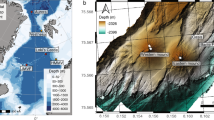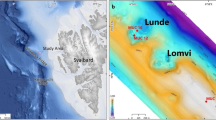Abstract
Substrates associated with active hydrocarbon vents in bathyal Gulf of Mexico support numerous foraminiferal species, with a few of them showing unusually high relative abundances. In the 584- to 695-m-depth range,Bolivina ordinaria, Gavelinopsis translucens, andCassidulina neocarinata strongly dominate the vent community, whereasBolivina subaenariensis andUvigerina laevis play this role around a vent at 216 m water depth. The bathymetric imprint on the foraminiferal record is also seen in theδ 18O compositions of some species, includingUvigerina peregrina. The adaptation of foraminiferal communities to bacterial (Beggiatoa) mats, in which the redox boundary is very close to the sediment—water interface, and anomalous depletions of13C inU. peregrina (relative to the same species from nonventing sites) indicate that several species are probably facultative anaerobes and tolerant of H2S toxicity.
Similar content being viewed by others
References
Aharon P (1991) Chronostratigraphy and bathymetry models of the last sea level cycle from paired planktonic/benthic foraminifera stable isotopes in the Gulf of Mexico slope sediments. Unpublished Exxon Corporation USA Report 150 pp
Aharon P and Sen Gupta BK (1994) Bathymetric reconstructions of the Miocene-age “calcari aLucina” (northern Apennines, Italy) from oxygen isotopes and benthic Foraminifera. Geo-Marine Letters 14:219–230
Aharon P, Roberts H, Sassen R, and Larkin J (1990) Stable isotopes and petrology of chimneys and calcareous fauna from hydrocarbon vents on the Gulf of Mexico slope. Geological Society of America, 1990 Annual Meeting, Abstracts with Programs A208
Aharon P, Graber ER, and Roberts HH (1992) Dissolved carbon andδ 13C anomalies in the water column caused by hydrocarbon seeps on the northwestern Gulf of Mexico slope. Geo-Marine Letters 12:33–40
Alve E (1990) Variations in estuarine foraminiferal biofacies with diminishing oxygen conditions in Dramensfjord, SE Norway. In: Hembleben C, Kaminski MA, Kuhnt W, and Scott DB (Eds.), Paleoecology, Biostratigraphy, Paleoceanography and Taxonomy of Agglutinated Foraminifera. Dordrecht: Kluwer Academic Publishers 661–694 pp
Barmawidjaja DM, Jorissen FJ, Puskaric S, and van der Zwaan GJ (1992) Microhabitat selection by benthic foraminifera in the northern Adriatic Sea. Journal of Foraminiferal Research 22:297–317
Bernhard JM (1988) Postmortem vital staining in benthic foraminifera: Duration and importance in population and distributional studies. Journal of Foraminiferal Research 16:207–215
Bernhard JM (1989) The distribution of benthic foraminifera with respect to oxygen concentration and organic carbon levels in shallow-water Antarctic sediments. Limnology and Oceanography 34:1131–1141
Bernhard JM (1993) Experimental and field evidence of Antarctic foraminiferal tolerance to anoxia and hydrogen sulfide. Marine Micropaleontology 20:203–213
Bernhard JM and Reimers CE (1991) Benthic foraminiferal population fluctuations related to anoxia: Santa Barbara Basin. Biogeochemistry 15:127–149
Brooks JM, Kennicutt MC, Fisher CR, Macko SA, Cole K, Childress JJ, Bidigare RR, and Vetter RD (1987) Deep-sea hydrocarbon seep communities: Evidence for energy and nutritional carbon sources. Science 238:1138–1142
Corliss BH and Emerson S (1990) Distribution of Rose Bengal stained deep-sea benthic Foraminifera from the Nova Scotian continental margin and Gulf of Maine. Deep-Sea Research 37:381–400
Craig H (1957) Isotopic standards for carbon and oxygen and correction factors for mass spectrometric analysis of carbon dioxide. Geochimica et Cosmochimica Acta 12:133–149
Denne RA (1990) Late Quaternary Foraminifera of the northwestern Gulf of Mexico. Unpublished doctoral dissertation. Baton Rouge: Louisiana State University 488 pp
Denne RA and Sen Gupta BK (1989) Effects of taphonomy and habitat on the record of benthic foraminifera in modern sediments. Palaios 4:414–423
Denne RA and Sen Gupta BK (1990) First and last occurrences of Quaternary benthic foraminifera in the Gulf of Mexico: Relation to paleoceanography. Transactions, Gulf Coast Association of Geological Societies 40:177–180
Denne RA and Sen Gupta BK (1991) Association of bathyal foraminifera with water masses in the northwestern Gulf of Mexico. Marine Micropaleontology 17:173–193
Graber ER, Aharon P, and Roberts HH (1990) Pore water chemistry from hydrocarbon vents on the Gulf of Mexico slope. Geological Society of America Abstracts with Programs 22:A208
Grossman EL (1987) Stable isotopes in modern benthic foraminifera: A study of vital effect. Journal of Foraminiferal Research 17:48–61
Jones RW (1993) Preliminary observations on benthonic foraminifera associated with biogenic gas seep in the North Sea. In: Jenkins DG (Ed.), Applied Micropaleontology. Dordrecht: Kluwer Academic Publishers 69–91 pp
Jorissen FJ, Barmawidjaja DM, Puskaric S, and van der Zwaan GJ (1992) Vertical distribution of benthic foraminifera in the northern Adriatic Sea: The relation with the organic flux. Marine Micropaleontology 19:131–146
Kaminski MA (1988) Cenozoic deep-water agglutinated Foraminifera in the North Atlantic. Unpublished doctoral dissertation. Cambridge/Woods Hole: Massachusetts Institute of Technology/Woods Hole Oceanographic Institution 262 pp
Kennicutt MC (1993) Geochemical processes. In: MacDonald IR and Schroeder WW (Eds.), Chemosynthetic Ecosystem Studies, Interim Report, OCS Study, MMS 93-0032. New Orleans: US Department of the Interior, Minerals Management Service, Gulf of Mexico OCS Regional Office 3-1–3-3, 12 pp
Kennicutt MC, Brooks JM, Bidigare RR, Fay RR, Wade TL, and McDonald TJ (1985) Vent-type taxa in a hydrocarbon seep region on the Louisiana Slope. Nature 317:351–353
Larkin JM and Strohl WR (1983)Beggiatoa, Thiothrix, andThioploca. Annual Review of Microbiology 37:341–367
Larkin J, Aharon P, and Henk MC (1994)Beggiatoa in microbial mats at hydrocarbon vents in the Gulf of Mexico and Warm Mineral Springs, Florida. Geo-Marine Letters 14:97–103
Lloyd D, Kristensen B, and Degn H (1981) Oxidative detoxification of hydrogen sulphide detected by mass spectrometry in the soil amoebaAcanthamoeba castellanii. Journal of General Microbiology 126:167–170
McCorkle DC, Keigwin LD, Corliss BH, Emerson SR (1990) The influence of microhabitats on the carbon isotope composition of deep sea benthic Foraminifera. Paleocenography 5:161–185
Mineral Management Service (1986) Visual No. 5: Geologic and Geomorphic Features. New Orleans: US Department of the Interior, Minerals Management Service, Gulf of Mexico OCS Regional Office 1 sheet
Molina-Cruz A and Ayala-López A (1988) Influence of the hydrothermal vents on the distribution of benthic foraminifera from the Guaymas Basin, Mexico. Geo-Marine Letters 8:49–56
Moodley L and Hess C (1992) Tolerance of infaunal benthic foraminifera for low and high oxygen concentrations. Biological Bulletin 183:94–98
Nienstedt JC and Arnold AJ (1988) The distribution of foraminifera on seamounts near the East Pacific Rise. Journal of Foraminiferal Research 18:237–249
Pflum CA and Frerichs WE (1976) Gulf of Mexico Deep-Water Foraminifers. Cushman Foundation for Foraminiferal Research 14:125 pp
Roberts HH and Aharon P (1994) Hydrocarbon-derived carbonate buildups of the northern Gulf of Mexico continental slope: A synthesis of submersible investigations. Geo-Marine Letters 14:135–148
Sassen R, Roberts HH, Aharon P, Larkin J, Chinn EW, and Carney R (1993) Chemosynthetic bacterial mats at cold hydrocarbon seeps, Gulf of Mexico continental slope. Organic Geochemistry 20:77–89
Sen Gupta BK and Machain-Castillo ML (1993) Benthic foraminifera in oxygen-poor habitats. Marine Micropaleontology 20:183–201
Sen Gupta BK, Lee RF, and May MS (1981) Upwelling and an unusual assemblage of benthic foraminifera on the northern Florida continental slope. Journal of Paleontology 55:853–857
Shackleton NJ (1974) Attainment of isotopic equilibrium between ocean water and the benthic foraminifera genusUvigerina: Isotopic changes in the ocean during the last glacial. Colloques Internationaux du CNRS 219:203–209
Shackleton NJ (1977) Carbon-13 inUvigerina: Tropical rainforest history and the equatorial Pacific carbonate dissolution cycles. In: Andersen NR, Malahoff A (Eds.), The Fate of Fossil Fuel CO2 in the Oceans. New York: Plenum Press 401–427 pp
Spies RB and Davis PH (1979) The infaunal benthos of a natural oil seep in the Santa Barbara Channel. Marine Biology 50:227–237
Stein JL, Cary SC, Hessler RR, Ohta S, Vetter RD, Childress JJ, and Felbeck H (1988) Chemautotrophic symbiosis in a hydrothermal vent gastropod. Biological Bulletin 174:373–378
Zahn R, Winn K, and Sarnthein M (1986) Benthic foraminiferalδ 13C and accumulation rates of organic carbon:Uvigerina peregrina group andCibicidoides wuellerstorfi. Paleoceanography 1:27–42
Author information
Authors and Affiliations
Rights and permissions
About this article
Cite this article
Sen Gupta, B.K., Aharon, P. Benthic foraminifera of bathyal hydrocarbon vents of the Gulf of Mexico: Initial report on communities and stable isotopes. Geo-Marine Letters 14, 88–96 (1994). https://doi.org/10.1007/BF01203719
Received:
Revised:
Issue Date:
DOI: https://doi.org/10.1007/BF01203719




